1985 FORD GRANADA engine
[x] Cancel search: enginePage 69 of 255

Other items
34Disconnect the throttle cable from the
operating lever and bracket.
35Disconnect the right-hand exhaust
downpipe from the manifold then remove the
starter motor, the oil filter, and disconnect the
left-hand exhaust downpipe, in that order.
Refer to Part A, Section 8, paragraphs 1 to 8
of this Chapter.
Cylinder head bolts on the V6 engine may
be conventional (hexagon-headed) or Torx
type. The appropriate Torx key will be needed
to deal with the latter.
Before dismantling the engine into its main
components, the following ancillaries can be
removed. The actual items removed, and the
sequence of removal, will depend on the work
to be done.
Distributor and bracket
Spark plugs
Inlet manifold and associated items
Exhaust manifolds
Clutch
Alternator and bracket
Oil pressure switch(see illustration) Temperature gauge sender
Engine bearer arms
Dipstick
If an oil cooler is fitted between the oil filter
and the block, remove it by disconnecting the
coolant hoses and unscrewing the central
sleeve. The cooler and seal can now be
removed. If the threaded bush is removed
from the block (it may come out with the
sleeve) it must be renewed.
The procedure is described for the engine in
the vehicle. With the engine removed, the
preliminary steps can be ignored.
2.8 litre engine
1Disconnect the battery negative lead.
2Remove the inlet manifold and associated
components.
3Unbolt the power steering pump, remove
the drivebelts and move the pump aside.
Support it by wiring it to adjacent
components.
4Remove the alternator and its bracket.
5Remove the three bolts which secure each
rocker shaft. Remove the shafts and
pushrods, keeping them in order so that they
can be refitted in the same locations.
6Unbolt the exhaust pipes from the
manifolds.
7Remove the spark plugs.8Slacken the cylinder head bolts half a turn at
a time, following the reverse sequence to that
used when tightening (see illustration 38.5).
Remove the bolts.
9Remove the cylinder heads. If they are
stuck, try to rock them free, or tap them with a
soft-faced hammer. Do nothit them directly
with a metal hammer, and do notlever in
between the joint faces.
10Recover the head gaskets.
2.4 & 2.9 litre engines
11Disconnect the battery and drain the
cooling system.
12Disconnect the radiator top hose and the
heater hose from the thermostat housing.
13Disconnect the air hoses from the throttle
valve housing (see illustration).
14Detach the two wiring plugs from the
airflow sensors (see illustrations).
15Pull the breather hose from the oil filler cap
(see illustration).
16Unclip the air cleaner cover and remove it
together with the airflow sensors and air hoses.
17Disconnect the hoses from the coolant
expansion tank.
18Disconnect the wiring from the following
components:
a)Alternator (right-hand cylinder head
removal only).
b)Coolant temperature sensors(see
illustration).
c)Idle speed control valve (see illustration).
d)Throttle valve potentiometer.
e)The fuel-injector wiring loom.8Cylinder heads - removal
7Ancillary components - removal
6Engine dismantling - general
2C•8V6 engines
7.1 The oil pressure switch is on the left-
hand side of the block
8.14b Throttle position sensor wiring plug
Vacuum nozzles arrowed
8.14a Front airflow sensor wiring plug
8.15 Oil filler breather hose (arrowed)8.18a Coolant temperature sensor location
8.13 Disconnecting the air hoses from the
throttle valve housing
procarmanuals.com
Page 70 of 255
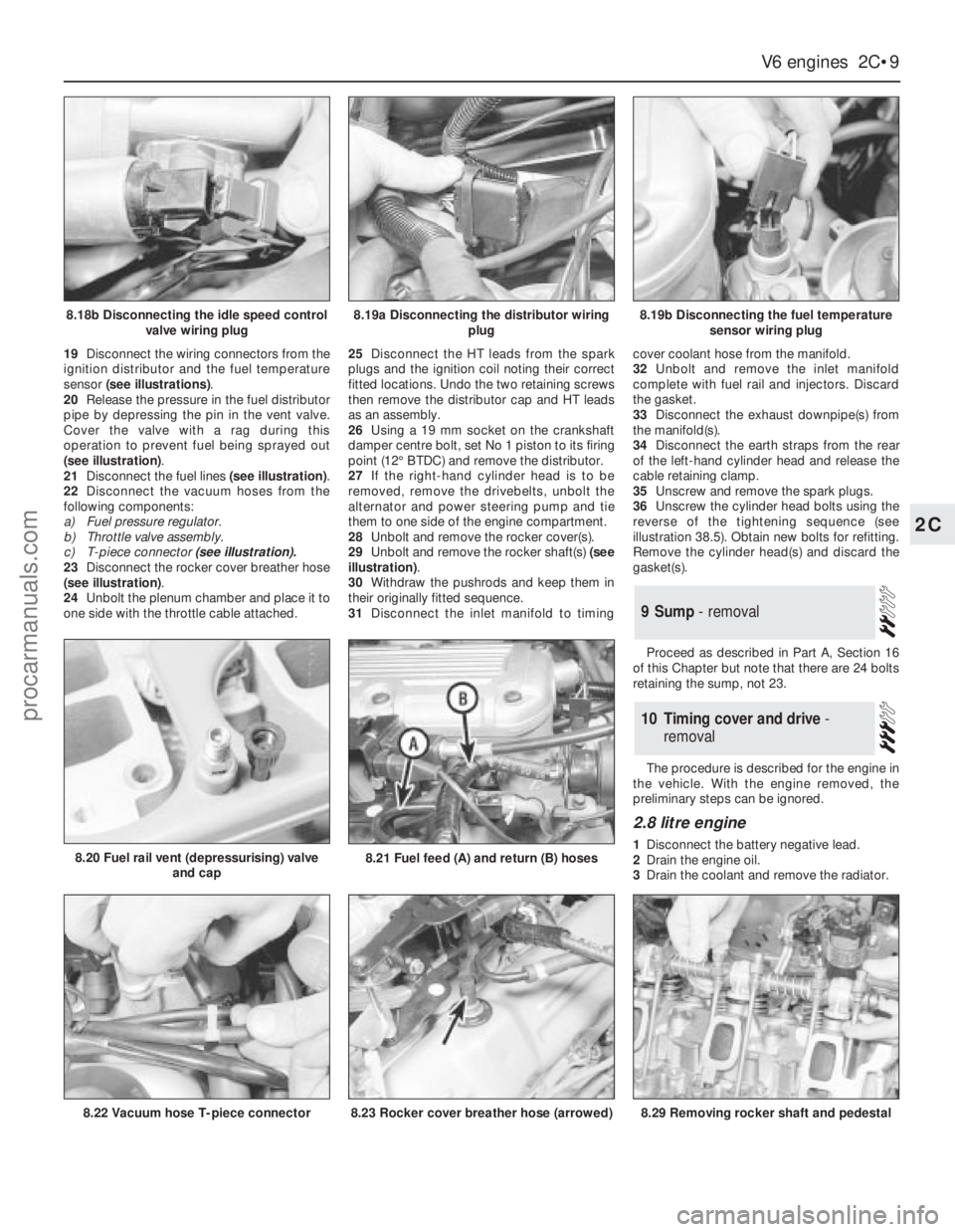
19Disconnect the wiring connectors from the
ignition distributor and the fuel temperature
sensor (see illustrations).
20Release the pressure in the fuel distributor
pipe by depressing the pin in the vent valve.
Cover the valve with a rag during this
operation to prevent fuel being sprayed out
(see illustration).
21Disconnect the fuel lines (see illustration).
22Disconnect the vacuum hoses from the
following components:
a)Fuel pressure regulator.
b)Throttle valve assembly.
c)T-piece connector (see illustration).
23Disconnect the rocker cover breather hose
(see illustration).
24Unbolt the plenum chamber and place it to
one side with the throttle cable attached.25Disconnect the HT leads from the spark
plugs and the ignition coil noting their correct
fitted locations. Undo the two retaining screws
then remove the distributor cap and HT leads
as an assembly.
26Using a 19 mm socket on the crankshaft
damper centre bolt, set No 1 piston to its firing
point (12°BTDC) and remove the distributor.
27If the right-hand cylinder head is to be
removed, remove the drivebelts, unbolt the
alternator and power steering pump and tie
them to one side of the engine compartment.
28Unbolt and remove the rocker cover(s).
29Unbolt and remove the rocker shaft(s) (see
illustration).
30Withdraw the pushrods and keep them in
their originally fitted sequence.
31Disconnect the inlet manifold to timingcover coolant hose from the manifold.
32Unbolt and remove the inlet manifold
complete with fuel rail and injectors. Discard
the gasket.
33Disconnect the exhaust downpipe(s) from
the manifold(s).
34Disconnect the earth straps from the rear
of the left-hand cylinder head and release the
cable retaining clamp.
35Unscrew and remove the spark plugs.
36Unscrew the cylinder head bolts using the
reverse of the tightening sequence (see
illustration 38.5). Obtain new bolts for refitting.
Remove the cylinder head(s) and discard the
gasket(s).
Proceed as described in Part A, Section 16
of this Chapter but note that there are 24 bolts
retaining the sump, not 23.
The procedure is described for the engine in
the vehicle. With the engine removed, the
preliminary steps can be ignored.
2.8 litre engine
1Disconnect the battery negative lead.
2Drain the engine oil.
3Drain the coolant and remove the radiator.
10Timing cover and drive -
removal
9Sump - removal
V6 engines 2C•9
2C
8.18b Disconnecting the idle speed control
valve wiring plug8.19a Disconnecting the distributor wiring
plug8.19b Disconnecting the fuel temperature
sensor wiring plug
8.22 Vacuum hose T-piece connector
8.20 Fuel rail vent (depressurising) valve
and cap8.21 Fuel feed (A) and return (B) hoses
8.23 Rocker cover breather hose (arrowed)8.29 Removing rocker shaft and pedestal
procarmanuals.com
Page 71 of 255
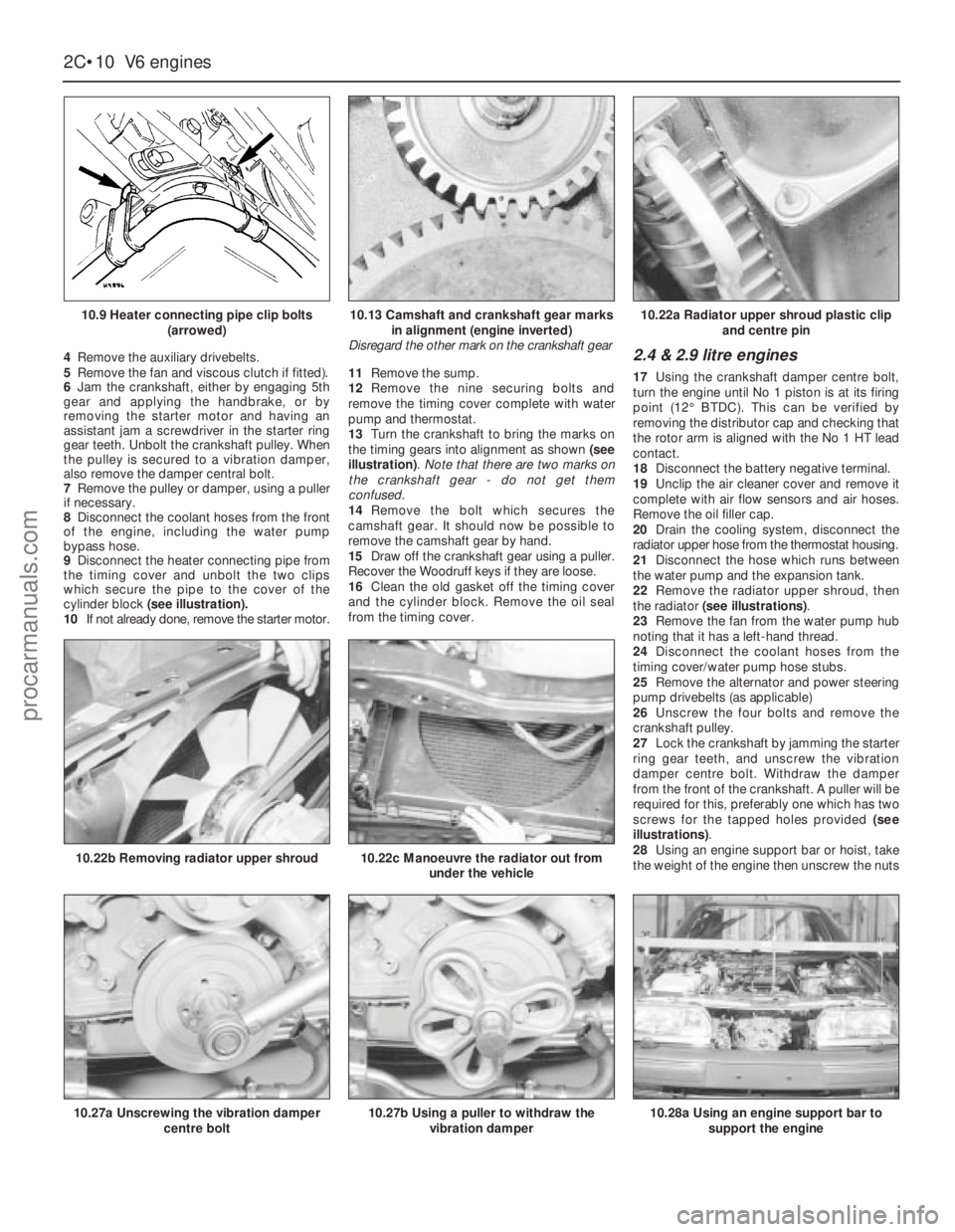
4Remove the auxiliary drivebelts.
5Remove the fan and viscous clutch if fitted).
6Jam the crankshaft, either by engaging 5th
gear and applying the handbrake, or by
removing the starter motor and having an
assistant jam a screwdriver in the starter ring
gear teeth. Unbolt the crankshaft pulley. When
the pulley is secured to a vibration damper,
also remove the damper central bolt.
7Remove the pulley or damper, using a puller
if necessary.
8Disconnect the coolant hoses from the front
of the engine, including the water pump
bypass hose.
9Disconnect the heater connecting pipe from
the timing cover and unbolt the two clips
which secure the pipe to the cover of the
cylinder block (see illustration).
10If not already done, remove the starter motor.11Remove the sump.
12Remove the nine securing bolts and
remove the timing cover complete with water
pump and thermostat.
13Turn the crankshaft to bring the marks on
the timing gears into alignment as shown (see
illustration). Note that there are two marks on
the crankshaft gear - do not get them
confused.
14Remove the bolt which secures the
camshaft gear. It should now be possible to
remove the camshaft gear by hand.
15Draw off the crankshaft gear using a puller.
Recover the Woodruff keys if they are loose.
16Clean the old gasket off the timing cover
and the cylinder block. Remove the oil seal
from the timing cover.2.4 & 2.9 litre engines
17Using the crankshaft damper centre bolt,
turn the engine until No 1 piston is at its firing
point (12°BTDC). This can be verified by
removing the distributor cap and checking that
the rotor arm is aligned with the No 1 HT lead
contact.
18Disconnect the battery negative terminal.
19Unclip the air cleaner cover and remove it
complete with air flow sensors and air hoses.
Remove the oil filler cap.
20Drain the cooling system, disconnect the
radiator upper hose from the thermostat housing.
21Disconnect the hose which runs between
the water pump and the expansion tank.
22Remove the radiator upper shroud, then
the radiator (see illustrations).
23Remove the fan from the water pump hub
noting that it has a left-hand thread.
24Disconnect the coolant hoses from the
timing cover/water pump hose stubs.
25Remove the alternator and power steering
pump drivebelts (as applicable)
26Unscrew the four bolts and remove the
crankshaft pulley.
27Lock the crankshaft by jamming the starter
ring gear teeth, and unscrew the vibration
damper centre bolt. Withdraw the damper
from the front of the crankshaft. A puller will be
required for this, preferably one which has two
screws for the tapped holes provided (see
illustrations).
28Using an engine support bar or hoist, take
the weight of the engine then unscrew the nuts
2C•10V6 engines
10.9 Heater connecting pipe clip bolts
(arrowed)
10.27a Unscrewing the vibration damper
centre bolt
10.22b Removing radiator upper shroud10.22c Manoeuvre the radiator out from
under the vehicle
10.27b Using a puller to withdraw the
vibration damper10.28a Using an engine support bar to
support the engine
10.13 Camshaft and crankshaft gear marks
in alignment (engine inverted)
Disregard the other mark on the crankshaft gear10.22a Radiator upper shroud plastic clip
and centre pin
procarmanuals.com
Page 72 of 255
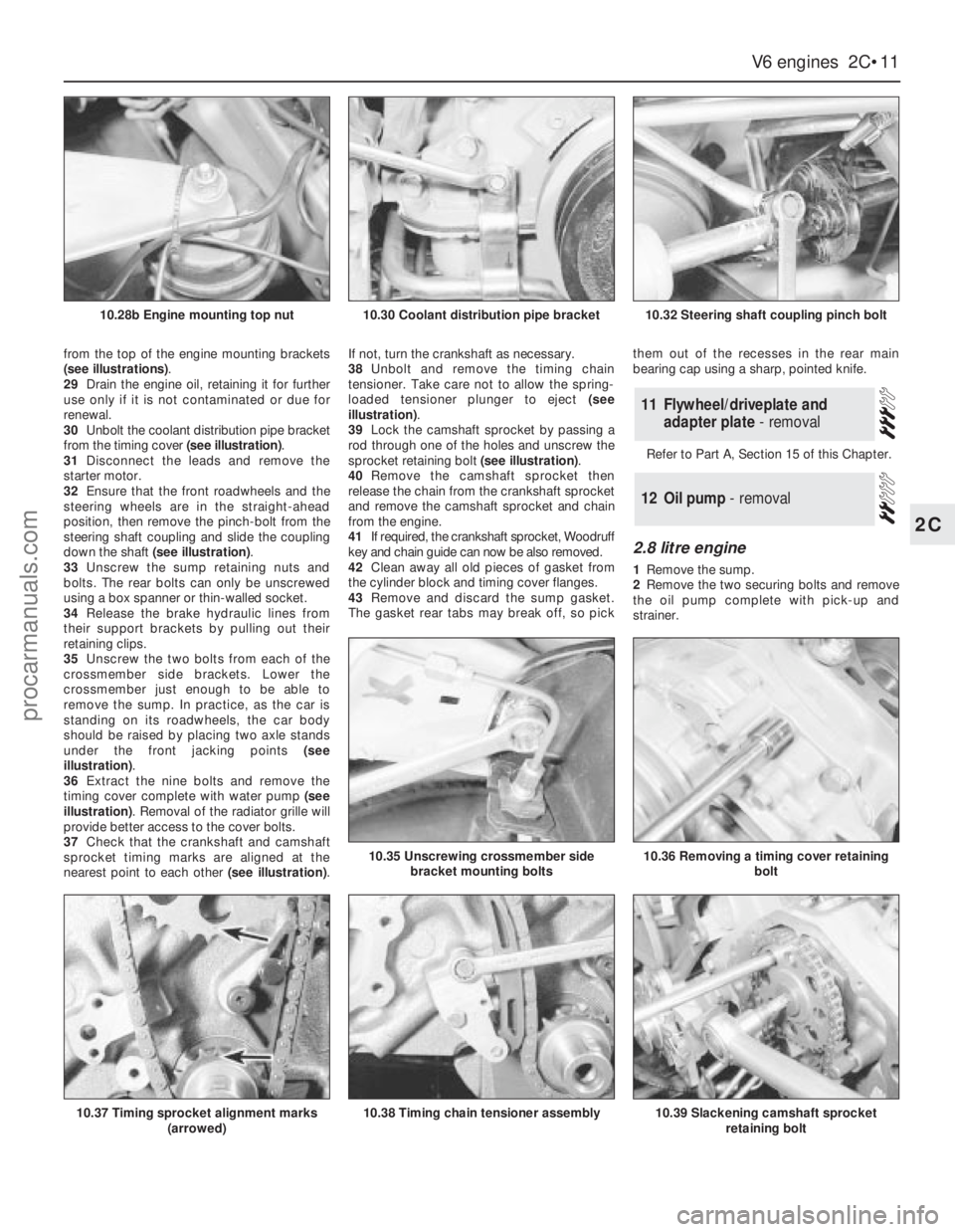
from the top of the engine mounting brackets
(see illustrations).
29Drain the engine oil, retaining it for further
use only if it is not contaminated or due for
renewal.
30Unbolt the coolant distribution pipe bracket
from the timing cover (see illustration).
31Disconnect the leads and remove the
starter motor.
32Ensure that the front roadwheels and the
steering wheels are in the straight-ahead
position, then remove the pinch-bolt from the
steering shaft coupling and slide the coupling
down the shaft (see illustration).
33Unscrew the sump retaining nuts and
bolts. The rear bolts can only be unscrewed
using a box spanner or thin-walled socket.
34Release the brake hydraulic lines from
their support brackets by pulling out their
retaining clips.
35Unscrew the two bolts from each of the
crossmember side brackets. Lower the
crossmember just enough to be able to
remove the sump. In practice, as the car is
standing on its roadwheels, the car body
should be raised by placing two axle stands
under the front jacking points (see
illustration).
36Extract the nine bolts and remove the
timing cover complete with water pump (see
illustration). Removal of the radiator grille will
provide better access to the cover bolts.
37Check that the crankshaft and camshaft
sprocket timing marks are aligned at the
nearest point to each other (see illustration).If not, turn the crankshaft as necessary.
38Unbolt and remove the timing chain
tensioner. Take care not to allow the spring-
loaded tensioner plunger to eject (see
illustration).
39Lock the camshaft sprocket by passing a
rod through one of the holes and unscrew the
sprocket retaining bolt (see illustration).
40Remove the camshaft sprocket then
release the chain from the crankshaft sprocket
and remove the camshaft sprocket and chain
from the engine.
41If required, the crankshaft sprocket, Woodruff
key and chain guide can now be also removed.
42Clean away all old pieces of gasket from
the cylinder block and timing cover flanges.
43Remove and discard the sump gasket.
The gasket rear tabs may break off, so pickthem out of the recesses in the rear main
bearing cap using a sharp, pointed knife.
Refer to Part A, Section 15 of this Chapter.
2.8 litre engine
1Remove the sump.
2Remove the two securing bolts and remove
the oil pump complete with pick-up and
strainer.
12Oil pump - removal
11Flywheel/driveplate and
adapter plate - removal
V6 engines 2C•11
2C
10.28b Engine mounting top nut10.30 Coolant distribution pipe bracket10.32 Steering shaft coupling pinch bolt
10.37 Timing sprocket alignment marks
(arrowed)
10.36 Removing a timing cover retaining
bolt10.35 Unscrewing crossmember side
bracket mounting bolts
10.38 Timing chain tensioner assembly10.39 Slackening camshaft sprocket
retaining bolt
procarmanuals.com
Page 73 of 255
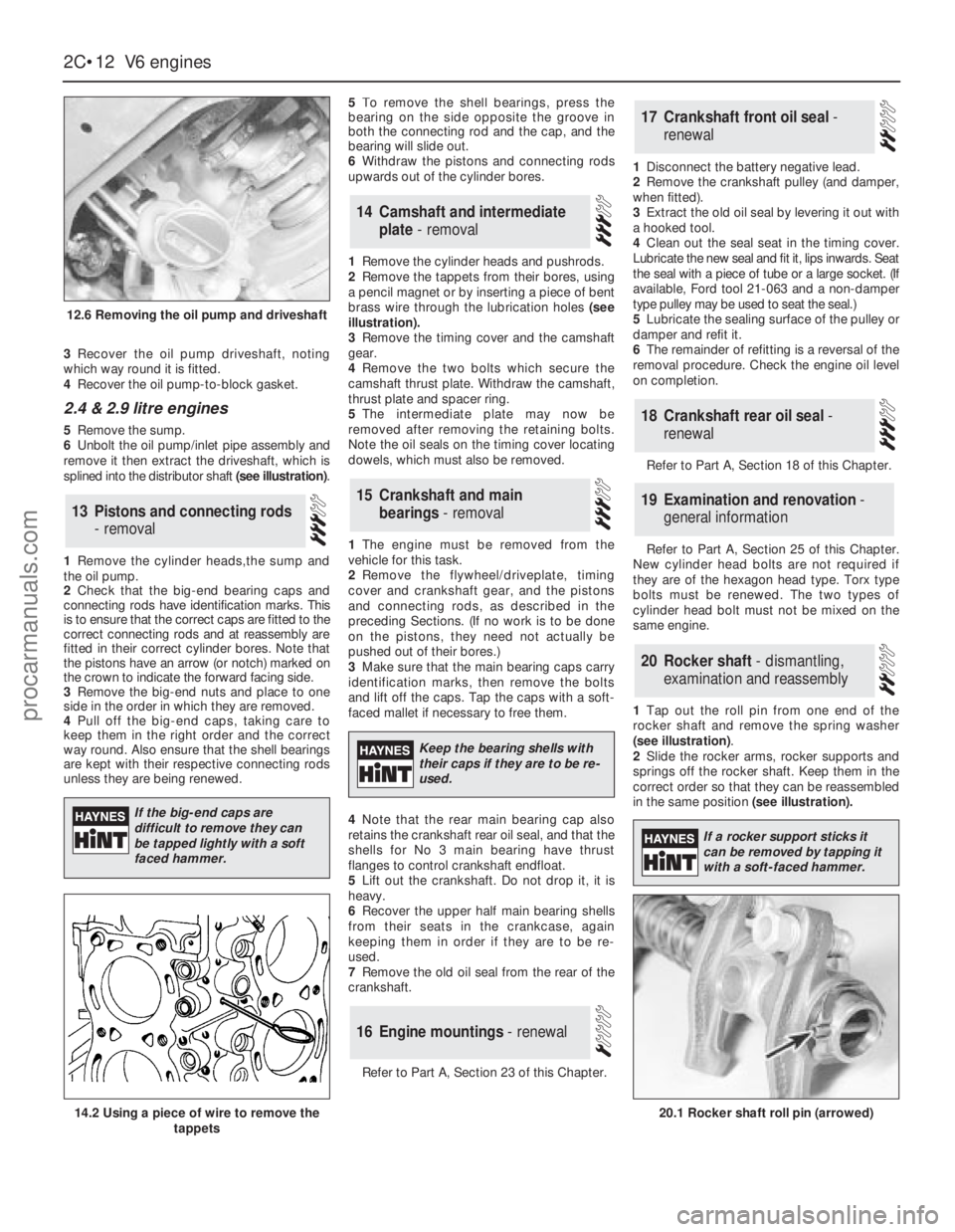
3Recover the oil pump driveshaft, noting
which way round it is fitted.
4Recover the oil pump-to-block gasket.
2.4 & 2.9 litre engines
5Remove the sump.
6Unbolt the oil pump/inlet pipe assembly and
remove it then extract the driveshaft, which is
splined into the distributor shaft (see illustration).
1Remove the cylinder heads,the sump and
the oil pump.
2Check that the big-end bearing caps and
connecting rods have identification marks. This
is to ensure that the correct caps are fitted to the
correct connecting rods and at reassembly are
fitted in their correct cylinder bores. Note that
the pistons have an arrow (or notch) marked on
the crown to indicate the forward facing side.
3Remove the big-end nuts and place to one
side in the order in which they are removed.
4Pull off the big-end caps, taking care to
keep them in the right order and the correct
way round. Also ensure that the shell bearings
are kept with their respective connecting rods
unless they are being renewed.5To remove the shell bearings, press the
bearing on the side opposite the groove in
both the connecting rod and the cap, and the
bearing will slide out.
6Withdraw the pistons and connecting rods
upwards out of the cylinder bores.
1Remove the cylinder heads and pushrods.
2Remove the tappets from their bores, using
a pencil magnet or by inserting a piece of bent
brass wire through the lubrication holes (see
illustration).
3Remove the timing cover and the camshaft
gear.
4Remove the two bolts which secure the
camshaft thrust plate. Withdraw the camshaft,
thrust plate and spacer ring.
5The intermediate plate may now be
removed after removing the retaining bolts.
Note the oil seals on the timing cover locating
dowels, which must also be removed.
1The engine must be removed from the
vehicle for this task.
2Remove the flywheel/driveplate, timing
cover and crankshaft gear, and the pistons
and connecting rods, as described in the
preceding Sections. (If no work is to be done
on the pistons, they need not actually be
pushed out of their bores.)
3Make sure that the main bearing caps carry
identification marks, then remove the bolts
and lift off the caps. Tap the caps with a soft-
faced mallet if necessary to free them.
4Note that the rear main bearing cap also
retains the crankshaft rear oil seal, and that the
shells for No 3 main bearing have thrust
flanges to control crankshaft endfloat.
5Lift out the crankshaft. Do not drop it, it is
heavy.
6Recover the upper half main bearing shells
from their seats in the crankcase, again
keeping them in order if they are to be re-
used.
7Remove the old oil seal from the rear of the
crankshaft.
Refer to Part A, Section 23 of this Chapter.1Disconnect the battery negative lead.
2Remove the crankshaft pulley (and damper,
when fitted).
3Extract the old oil seal by levering it out with
a hooked tool.
4Clean out the seal seat in the timing cover.
Lubricate the new seal and fit it, lips inwards. Seat
the seal with a piece of tube or a large socket. (If
available, Ford tool 21-063 and a non-damper
type pulley may be used to seat the seal.)
5Lubricate the sealing surface of the pulley or
damper and refit it.
6The remainder of refitting is a reversal of the
removal procedure. Check the engine oil level
on completion.
Refer to Part A, Section 18 of this Chapter.
Refer to Part A, Section 25 of this Chapter.
New cylinder head bolts are not required if
they are of the hexagon head type. Torx type
bolts must be renewed. The two types of
cylinder head bolt must not be mixed on the
same engine.
1Tap out the roll pin from one end of the
rocker shaft and remove the spring washer
(see illustration).
2Slide the rocker arms, rocker supports and
springs off the rocker shaft. Keep them in the
correct order so that they can be reassembled
in the same position (see illustration).
20Rocker shaft - dismantling,
examination and reassembly
19Examination and renovation -
general information
18Crankshaft rear oil seal -
renewal
17Crankshaft front oil seal -
renewal
16Engine mountings - renewal
15Crankshaft and main
bearings - removal
14Camshaft and intermediate
plate - removal
13Pistons and connecting rods
- removal
2C•12V6 engines
12.6 Removing the oil pump and driveshaft
20.1 Rocker shaft roll pin (arrowed)14.2 Using a piece of wire to remove the
tappets
If the big-end caps are
difficult to remove they can
be tapped lightly with a soft
faced hammer.
Keep the bearing shells with
their caps if they are to be re-
used.
If a rocker support sticks it
can be removed by tapping it
with a soft-faced hammer.
procarmanuals.com
Page 74 of 255
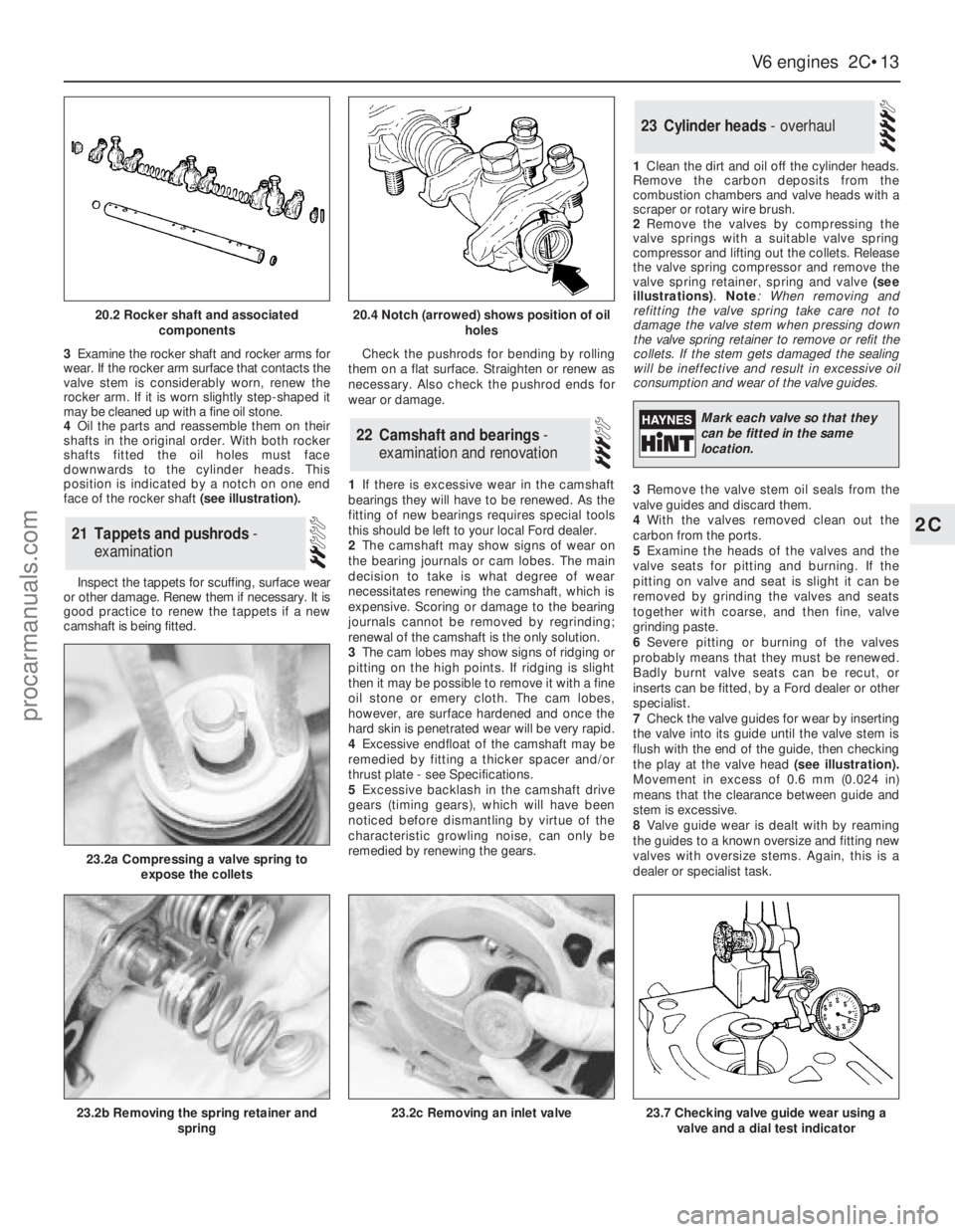
3Examine the rocker shaft and rocker arms for
wear. If the rocker arm surface that contacts the
valve stem is considerably worn, renew the
rocker arm. If it is worn slightly step-shaped it
may be cleaned up with a fine oil stone.
4Oil the parts and reassemble them on their
shafts in the original order. With both rocker
shafts fitted the oil holes must face
downwards to the cylinder heads. This
position is indicated by a notch on one end
face of the rocker shaft (see illustration).
Inspect the tappets for scuffing, surface wear
or other damage. Renew them if necessary. It is
good practice to renew the tappets if a new
camshaft is being fitted.Check the pushrods for bending by rolling
them on a flat surface. Straighten or renew as
necessary. Also check the pushrod ends for
wear or damage.
1If there is excessive wear in the camshaft
bearings they will have to be renewed. As the
fitting of new bearings requires special tools
this should be left to your local Ford dealer.
2The camshaft may show signs of wear on
the bearing journals or cam lobes. The main
decision to take is what degree of wear
necessitates renewing the camshaft, which is
expensive. Scoring or damage to the bearing
journals cannot be removed by regrinding;
renewal of the camshaft is the only solution.
3The cam lobes may show signs of ridging or
pitting on the high points. If ridging is slight
then it may be possible to remove it with a fine
oil stone or emery cloth. The cam lobes,
however, are surface hardened and once the
hard skin is penetrated wear will be very rapid.
4Excessive endfloat of the camshaft may be
remedied by fitting a thicker spacer and/or
thrust plate - see Specifications.
5Excessive backlash in the camshaft drive
gears (timing gears), which will have been
noticed before dismantling by virtue of the
characteristic growling noise, can only be
remedied by renewing the gears.1Clean the dirt and oil off the cylinder heads.
Remove the carbon deposits from the
combustion chambers and valve heads with a
scraper or rotary wire brush.
2Remove the valves by compressing the
valve springs with a suitable valve spring
compressor and lifting out the collets. Release
the valve spring compressor and remove the
valve spring retainer, spring and valve (see
illustrations).Note: When removing and
refitting the valve spring take care not to
damage the valve stem when pressing down
the valve spring retainer to remove or refit the
collets. If the stem gets damaged the sealing
will be ineffective and result in excessive oil
consumption and wear of the valve guides.
3Remove the valve stem oil seals from the
valve guides and discard them.
4With the valves removed clean out the
carbon from the ports.
5Examine the heads of the valves and the
valve seats for pitting and burning. If the
pitting on valve and seat is slight it can be
removed by grinding the valves and seats
together with coarse, and then fine, valve
grinding paste.
6Severe pitting or burning of the valves
probably means that they must be renewed.
Badly burnt valve seats can be recut, or
inserts can be fitted, by a Ford dealer or other
specialist.
7Check the valve guides for wear by inserting
the valve into its guide until the valve stem is
flush with the end of the guide, then checking
the play at the valve head(see illustration).
Movement in excess of 0.6 mm (0.024 in)
means that the clearance between guide and
stem is excessive.
8Valve guide wear is dealt with by reaming
the guides to a known oversize and fitting new
valves with oversize stems. Again, this is a
dealer or specialist task.
23Cylinder heads - overhaul
22Camshaft and bearings -
examination and renovation
21Tappets and pushrods -
examination
V6 engines 2C•13
2C
20.2 Rocker shaft and associated
components20.4 Notch (arrowed) shows position of oil
holes
23.2a Compressing a valve spring to
expose the collets
23.2b Removing the spring retainer and
spring23.2c Removing an inlet valve23.7 Checking valve guide wear using a
valve and a dial test indicator
Mark each valve so that they
can be fitted in the same
location.
procarmanuals.com
Page 75 of 255
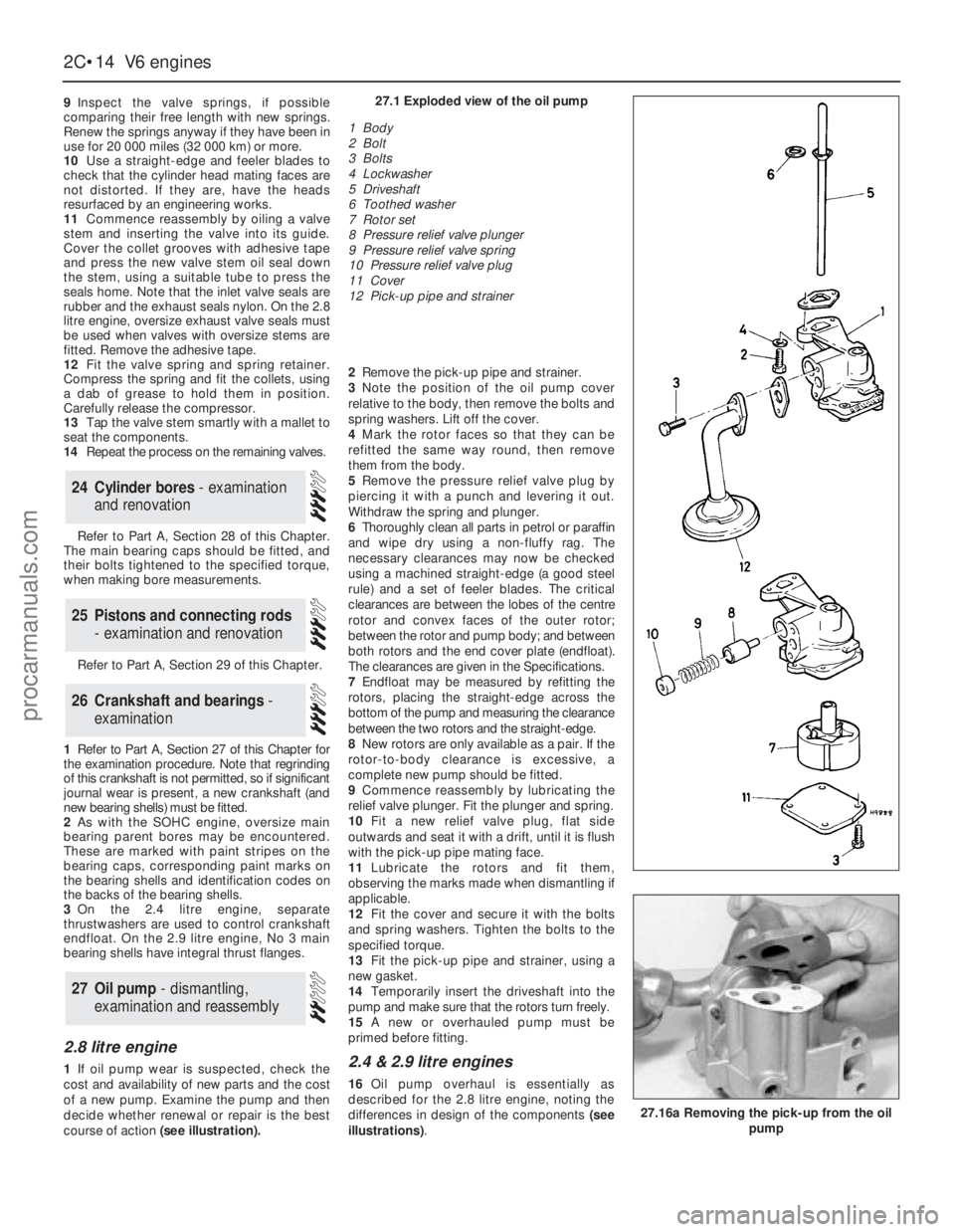
9Inspect the valve springs, if possible
comparing their free length with new springs.
Renew the springs anyway if they have been in
use for 20 000 miles (32 000 km) or more.
10Use a straight-edge and feeler blades to
check that the cylinder head mating faces are
not distorted. If they are, have the heads
resurfaced by an engineering works.
11Commence reassembly by oiling a valve
stem and inserting the valve into its guide.
Cover the collet grooves with adhesive tape
and press the new valve stem oil seal down
the stem, using a suitable tube to press the
seals home. Note that the inlet valve seals are
rubber and the exhaust seals nylon. On the 2.8
litre engine, oversize exhaust valve seals must
be used when valves with oversize stems are
fitted. Remove the adhesive tape.
12Fit the valve spring and spring retainer.
Compress the spring and fit the collets, using
a dab of grease to hold them in position.
Carefully release the compressor.
13Tap the valve stem smartly with a mallet to
seat the components.
14Repeat the process on the remaining valves.
Refer to Part A, Section 28 of this Chapter.
The main bearing caps should be fitted, and
their bolts tightened to the specified torque,
when making bore measurements.
Refer to Part A, Section 29 of this Chapter.
1Refer to Part A, Section 27 of this Chapter for
the examination procedure. Note that regrinding
of this crankshaft is not permitted, so if significant
journal wear is present, a new crankshaft (and
new bearing shells) must be fitted.
2As with the SOHC engine, oversize main
bearing parent bores may be encountered.
These are marked with paint stripes on the
bearing caps, corresponding paint marks on
the bearing shells and identification codes on
the backs of the bearing shells.
3On the 2.4 litre engine, separate
thrustwashers are used to control crankshaft
endfloat. On the 2.9 litre engine, No 3 main
bearing shells have integral thrust flanges.
2.8 litre engine
1If oil pump wear is suspected, check the
cost and availability of new parts and the cost
of a new pump. Examine the pump and then
decide whether renewal or repair is the best
course of action (see illustration).2Remove the pick-up pipe and strainer.
3Note the position of the oil pump cover
relative to the body, then remove the bolts and
spring washers. Lift off the cover.
4Mark the rotor faces so that they can be
refitted the same way round, then remove
them from the body.
5Remove the pressure relief valve plug by
piercing it with a punch and levering it out.
Withdraw the spring and plunger.
6Thoroughly clean all parts in petrol or paraffin
and wipe dry using a non-fluffy rag. The
necessary clearances may now be checked
using a machined straight-edge (a good steel
rule) and a set of feeler blades. The critical
clearances are between the lobes of the centre
rotor and convex faces of the outer rotor;
between the rotor and pump body; and between
both rotors and the end cover plate (endfloat).
The clearances are given in the Specifications.
7Endfloat may be measured by refitting the
rotors, placing the straight-edge across the
bottom of the pump and measuring the clearance
between the two rotors and the straight-edge.
8New rotors are only available as a pair. If the
rotor-to-body clearance is excessive, a
complete new pump should be fitted.
9Commence reassembly by lubricating the
relief valve plunger. Fit the plunger and spring.
10Fit a new relief valve plug, flat side
outwards and seat it with a drift, until it is flush
with the pick-up pipe mating face.
11Lubricate the rotors and fit them,
observing the marks made when dismantling if
applicable.
12Fit the cover and secure it with the bolts
and spring washers. Tighten the bolts to the
specified torque.
13Fit the pick-up pipe and strainer, using a
new gasket.
14Temporarily insert the driveshaft into the
pump and make sure that the rotors turn freely.
15A new or overhauled pump must be
primed before fitting.2.4 & 2.9 litre engines
16Oil pump overhaul is essentially as
described for the 2.8 litre engine, noting the
differences in design of the components (see
illustrations).
27Oil pump - dismantling,
examination and reassembly
26Crankshaft and bearings -
examination
25Pistons and connecting rods
- examination and renovation
24Cylinder bores - examination
and renovation
2C•14V6 engines
27.16a Removing the pick-up from the oil
pump
27.1 Exploded view of the oil pump
1 Body
2 Bolt
3 Bolts
4 Lockwasher
5 Driveshaft
6 Toothed washer
7 Rotor set
8 Pressure relief valve plunger
9 Pressure relief valve spring
10 Pressure relief valve plug
11 Cover
12 Pick-up pipe and strainer
procarmanuals.com
Page 76 of 255
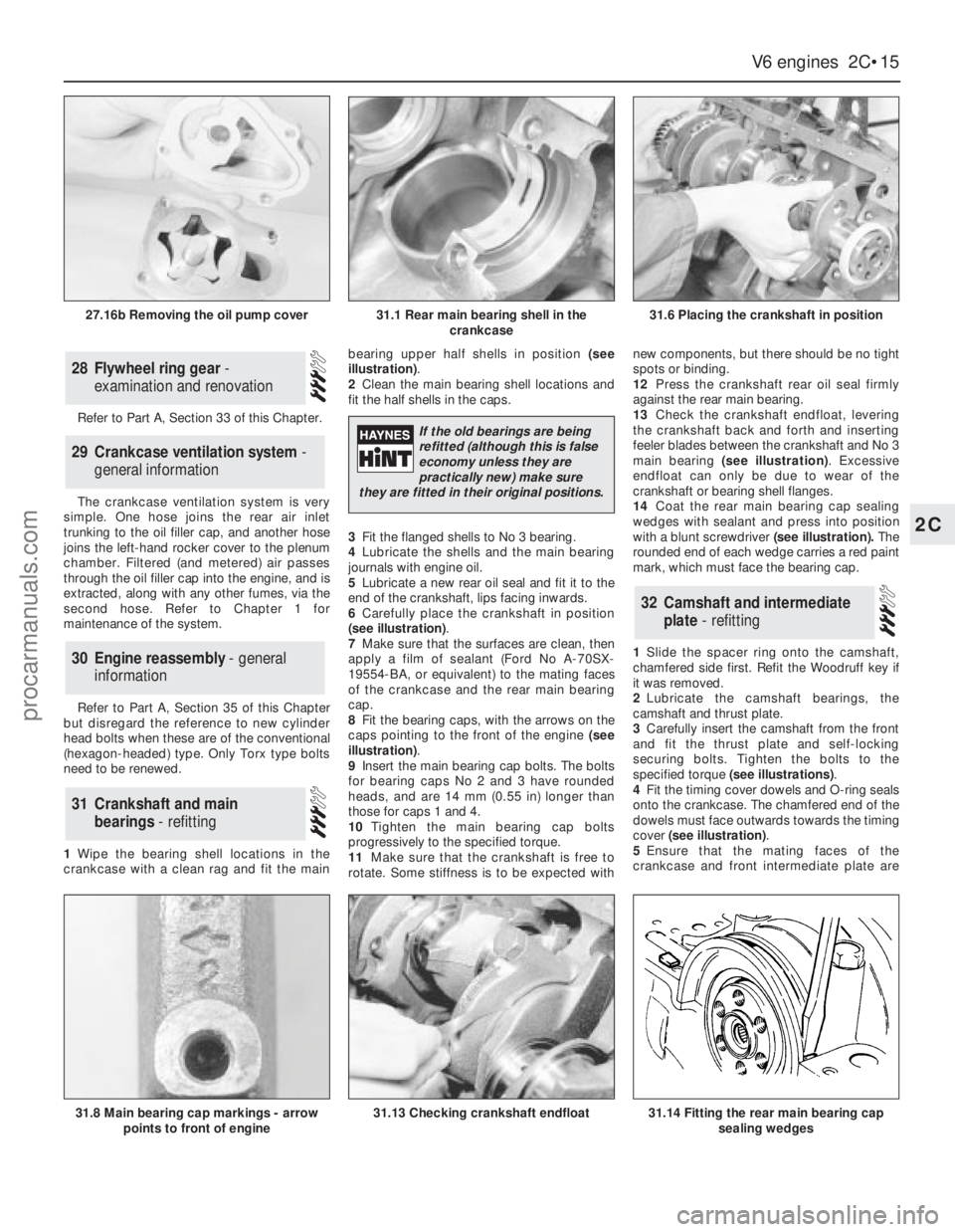
Refer to Part A, Section 33 of this Chapter.
The crankcase ventilation system is very
simple. One hose joins the rear air inlet
trunking to the oil filler cap, and another hose
joins the left-hand rocker cover to the plenum
chamber. Filtered (and metered) air passes
through the oil filler cap into the engine, and is
extracted, along with any other fumes, via the
second hose. Refer to Chapter 1 for
maintenance of the system.
Refer to Part A, Section 35 of this Chapter
but disregard the reference to new cylinder
head bolts when these are of the conventional
(hexagon-headed) type. Only Torx type bolts
need to be renewed.
1Wipe the bearing shell locations in the
crankcase with a clean rag and fit the mainbearing upper half shells in position (see
illustration).
2Clean the main bearing shell locations and
fit the half shells in the caps.
3Fit the flanged shells to No 3 bearing.
4Lubricate the shells and the main bearing
journals with engine oil.
5Lubricate a new rear oil seal and fit it to the
end of the crankshaft, lips facing inwards.
6Carefully place the crankshaft in position
(see illustration).
7Make sure that the surfaces are clean, then
apply a film of sealant (Ford No A-70SX-
19554-BA, or equivalent) to the mating faces
of the crankcase and the rear main bearing
cap.
8Fit the bearing caps, with the arrows on the
caps pointing to the front of the engine (see
illustration).
9Insert the main bearing cap bolts. The bolts
for bearing caps No 2 and 3 have rounded
heads, and are 14 mm (0.55 in) longer than
those for caps 1 and 4.
10Tighten the main bearing cap bolts
progressively to the specified torque.
11Make sure that the crankshaft is free to
rotate. Some stiffness is to be expected withnew components, but there should be no tight
spots or binding.
12Press the crankshaft rear oil seal firmly
against the rear main bearing.
13Check the crankshaft endfloat, levering
the crankshaft back and forth and inserting
feeler blades between the crankshaft and No 3
main bearing (see illustration). Excessive
endfloat can only be due to wear of the
crankshaft or bearing shell flanges.
14Coat the rear main bearing cap sealing
wedges with sealant and press into position
with a blunt screwdriver(see illustration).The
rounded end of each wedge carries a red paint
mark, which must face the bearing cap.
1Slide the spacer ring onto the camshaft,
chamfered side first. Refit the Woodruff key if
it was removed.
2Lubricate the camshaft bearings, the
camshaft and thrust plate.
3Carefully insert the camshaft from the front
and fit the thrust plate and self-locking
securing bolts. Tighten the bolts to the
specified torque (see illustrations).
4Fit the timing cover dowels and O-ring seals
onto the crankcase. The chamfered end of the
dowels must face outwards towards the timing
cover (see illustration).
5Ensure that the mating faces of the
crankcase and front intermediate plate are
32Camshaft and intermediate
plate - refitting
31Crankshaft and main
bearings - refitting
30Engine reassembly - general
information
29Crankcase ventilation system -
general information
28Flywheel ring gear -
examination and renovation
V6 engines 2C•15
2C
31.1 Rear main bearing shell in the
crankcase31.6 Placing the crankshaft in position
31.8 Main bearing cap markings - arrow
points to front of engine31.13 Checking crankshaft endfloat31.14 Fitting the rear main bearing cap
sealing wedges
27.16b Removing the oil pump cover
If the old bearings are being
refitted (although this is false
economy unless they are
practically new) make sure
they are fitted in their original positions.
procarmanuals.com